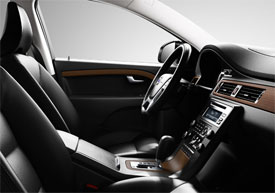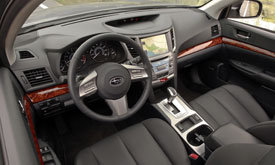2010 Subaru Outback / 2010 Volvo XC70
Prior to the rise of the minivan and SUV, Americans explored their country in station wagons. And though the wagon market continues to slowly fad into automotive history, there are a few modern wagons that still have some fight left in them. This week we look at two family station wagons, one a pioneer in safety, and the other a pioneer in all-wheel drive, to check out this unique appeal.
We selected the 2010 Subaru Outback and the 2010 Volvo XC70 because they are both almost the same size, can be equipped with similar features, and have all-wheel drive standard. Since the Volvo XC70 is the more luxurious of the two from the get-go, we leveled the playing field by matching it with the top-tier Outback Limited.
Volvo has been an American benchmark for station wagons since the 1960s. The XC70 is Volvo’s current top square back, with a front drive V70, and smaller V50 also available. The XC70’s long-low shape is familiar from prep schools to shopping malls.
The interior is the definition of high-quality with ultra-clean Swedish design. The expansive dash is ergonomically correct, if visually a bit dated. The orthopedically designed seats are also flat, but well-padded, and very comfortable front and rear.
 Being a premium-class vehicle, the XC70 offers a wide array of standard and optional amenities including wood, leather, seat memory, and navigation. Seat heat is a part of the Climate Package. And Volvo’s renowned safety commitment is seen in features like SIPS advanced side impact protection, and an available integrated child booster seat.
Being a premium-class vehicle, the XC70 offers a wide array of standard and optional amenities including wood, leather, seat memory, and navigation. Seat heat is a part of the Climate Package. And Volvo’s renowned safety commitment is seen in features like SIPS advanced side impact protection, and an available integrated child booster seat.
Overall 5-passenger room is ample, but the XC70 really delivers in the way of cargo capacity. Fold down the second row’s highly-versatile 40/20/40 split-seatbacks and this wagon makes way for 72.1 cubic feet of family gear. Plus, the optional power tailgate makes loading that gear easier.
Under the hood of the standard Volvo XC70 3.2 is a 235-horsepower 3.2-liter inline-six. The optional T6 model sports a 281-horsepower 3.0-liter turbocharged I6. Both engines tie to a six-speed automatic with manual shift mode. Our turbocharged T6 delighted us with its 0 to 60 sprint of only 6.3 seconds. That’s hot for any wagon.
But on normal roads, it was a bit of a different story. The XC70 felt large and heavy. The Haldex all-wheel drive system does provide confidence and a nice, planted feel. Ride quality is also high. Still, our drive left us uninspired. Government Fuel Economy Ratings for our Volvo XC70 T6 are a routine 16 city/21 highway on regular gas.
The original Subaru Outback combined wagon garagability with an outdoorsy utility, resulting in the world’s first Sport Utility Wagon. Inside, the 4th generation Outback boasts a spacious and well-conceived cabin. Interior materials are not as high quality as the XC70, but the sectioned dash is certainly more modern in appearance.
Our well-equipped Limited went toe-to-toe with the Volvo on premium amenities. Woody appliqués and leather trim with front seat heat are standard, although seat memory is not available. While the Outback's seats are not as comfortable or supportive as the XC70's, they too served us well on long trips.
The roomy rear seat boasts three more inches of legroom than the XC70. There is also a recline feature. The 60/40 split fold isn't as useful as the tri-section Volvo, but it still provides good versatility. And with the rear seats down, the Outback's 71.3 cubic feet cargo room is right on par with the XC70. However, there is no power liftgate available on the Outback.
 Outback power is either a 170-horsepower 2.5-liter flat-four in the 2.5i, or a 256-horsepower 3.6-liter flat-six in the 3.6R. The H4 pairs with either a six-speed manual or a CVT automatic, while the H6 joins a five-speed automatic with paddle shift.
Outback power is either a 170-horsepower 2.5-liter flat-four in the 2.5i, or a 256-horsepower 3.6-liter flat-six in the 3.6R. The H4 pairs with either a six-speed manual or a CVT automatic, while the H6 joins a five-speed automatic with paddle shift.
While no match for the Volvo T6, the Outback 3.6R still equates itself fine in a straight line with 0 to 60 of 7.1 seconds. Moreover, it scoots through traffic with a higher level of agility. The ride is not Volvo smooth, and you do hear a lot more noise. Still, in the daily grin, the Outback felt lighter, more responsive, and was more enjoyable to drive. Our Outback 3.6R also won the economy rating at 18 city/25 highway on regular gas.
So what we have here are two capable, well-packaged wagons, each with lots to offer. The Volvo XC70 has the edge in prestige and luxury fitment, while the Subaru Outback comes out ahead in the driving experience and fuel economy. And then there is value. Base sticker for the XC70 starts at $38,800. The Climate Package with heated seats adds $900 more.
Although base pricing for the Outback is a budget-friendly $23,690, the more comparably equipped Outback Limited 3.6R begins at $31,690. Still, that's over seven grand less than the XC70 before options, and it tilts this comparison sharply towards the Outback.
It's obvious the age of the station wagon is coming to a close. But, for the diehard wagon faithful, no crossover will do. To them, the square back "family truckster" will always be the only way to see America.Specifications
- Engine: 3.0-Liter Turbocharged I-6
- Horsepower: 281
- 0-60 MPH: 6.3 Seconds
- EPA: 16 MPG City/ 21 MPG Highway
- 2010 Subaru Outback:
- 2010 Volvo XC70:






